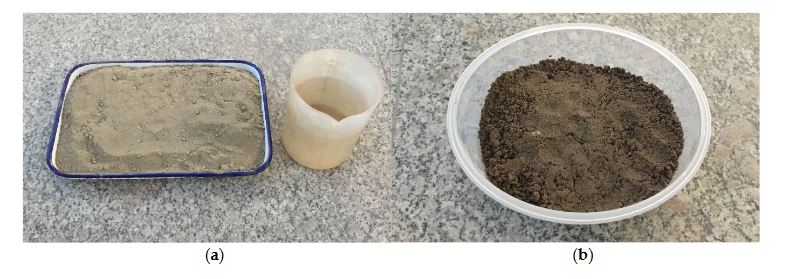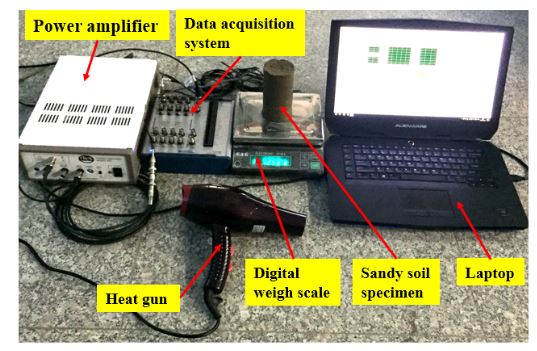ABSTRACT
A quantitative understanding of soil water content or soil water status is of great importance to many applications, such as landslide monitoring, rockfill dam health monitoring, precision agriculture, etc. In this paper, a feasibility study was conducted to monitor the soil water content in real time using permanent embedded piezoceramic-based transducers called smart aggregates (SAs).
An active sensing approach using a customized swept acoustic wave with a frequency range between 100 Hz and 300 kHz was used to study the wave attenuation in the soil in correlation to soil moisture levels. Two sandy soil specimens, each embedded with a pair of SAs, were made in the laboratory, and the water percentage of the soil specimens was incrementally decreased from 15% to 3% during the tests. Due to the change of the soil water status, the damping property of the soil correspondingly changes.
The change of the damping property results in the variation of the acoustic wave attenuation ratios. A wavelet packet-based energy index was adopted to compute the energy of the signal captured by the SA sensor. Experimental results show a parabolic growth curve of the received signal energy vs. the water percentage of the soil. The feasibility, sensitivity, and reliability of the proposed method for in-situ monitoring of soil water status were discussed.
SHEAR MODE SMART AGGREGATES

Figure 1. Shear mode SA: (a) the structure of a shear mode SA, (b) a photo of a shear mode SA
Previous research has shown that the shear wave is more sensitive in monitoring the materials that subject to water content change. Therefore, a shear mode SA, which was designed by sandwiching a shear mode Lead Zirconate Titanate (PZT d15) patch between two mating marble blocks, was investigated in this research. Figure 1 gives the structure and a photo of the shear mode SA.
PRINCIPLES
A stress wave-based active sensing approach using piezoceramic-based transducers has been adopted in structural health monitoring research for many years. In the active sensing approach, selected piezoceramic-based transducers are used as actuators to generate a designed stress wave; meanwhile, others are used as sensors to detect the wave response.
EXPERIMENTAL SETUP

Figure 2. Preparation of the sandy soil. (a) Dry sand, (b) Sand soil (15% water content)
Figure 2 shows the dry sand (0% water content) an d the water-mixed sandy soil. In this research, very fine sand was selected. The particle size was about 0.0625 mm (diameter). A digital weigh scale was used to measure the water content in the sandy soil. The gravimetric moisture content scale is used to this study.

Figure 4. Experimental setup
The experimental setup is shown in Figure 4. During the test, a heat gun was used to evaporate the water from the sandy soil specimen, so that the water content was reduced. By using the digital weigh scale to measure the weight of the sandy soil specimen in real time, the water content of the sandy soil specimen was incrementally decreased from 15% to 3%.
EXPERIMENTAL RESULTS

Figure 5. Time-domain signal response of the two test specimens. (a) Specimen 1, (b) Specimen 2
The time-domain of the signal responses of the two sandy soil specimens at 15%, 9%, and 3% are shown in Figure 5. It can be seen that, as the water content in the sandy soil specimen decreases, the amplitude of the signal decreases. The possible reason is that, when the water content in the sandy soil specimen decreases, the stiffness of the sandy soil specimen increases, resulting in a decrease in the stress wave attenuation.
DISCUSSION
In this research, the feasibility of using SA-based technologies to monitor the soil water content is verified. The combination of the active sensing approach and the durable SAs offers the possibility of employing the proposed approach with embedded sensors to monitor the soil water content in real time. As shown in Figure 6, the energy value of the received signal is parabolically related to the water content in the sandy soil. The two repeated tests yielded similar results.
CONCLUSIONS
In this paper, an active sensing approach using shear mode SAs successfully monitored the water content in sandy soil in real time. As the water content decreases in the sandy soil, the amplitude of the corresponding signal increases. The received signal energy values computed by using a wavelet packet-based energy approach is capable of quantitatively monitoring the water content of sandy soil.
As shown in the experimental results, the parabolic relationship between the stress wave attenuation and soil water content was found, such that the results could have potentials and provide guidance in extending the current civil applications of SAs in the geotechnical field, specifically for monitoring the soil water content. In the authors’ future work, the sensitivity and reliability of the proposed method will be further investigated. In addition, more soil types and soil conditions will be investigated to verify the validity of the proposed approach. An appropriate calibration method will also be studied.
Source: University of Houston
Authors: Qingzhao Kong | Hongli Chen | Yi-lung Mo | Gangbing Song